作者:Bruce
原文:https://zhuanlan.zhihu.com/p/17186885141

前言
笔者一直想找个开源的推理引擎框架学习一下源代码,机缘巧合认识了 sglang 社区的朋友,于是也参与了一些sglang的code walk through。本文从我个人角度,解析一下sglang kv cache 管理相关的源码部分。
对于今后想要学习sglang的同学,首先强烈建议先阅读 flashinfer[1] 的论文,flashinfer 作为sglang的默认后端,从中可以了解一些底层的设计思路。另外,建议阅读 code walk through[2](还在紧锣密鼓的进行),大家有兴趣也可以参与进来。下图即引用自社区。
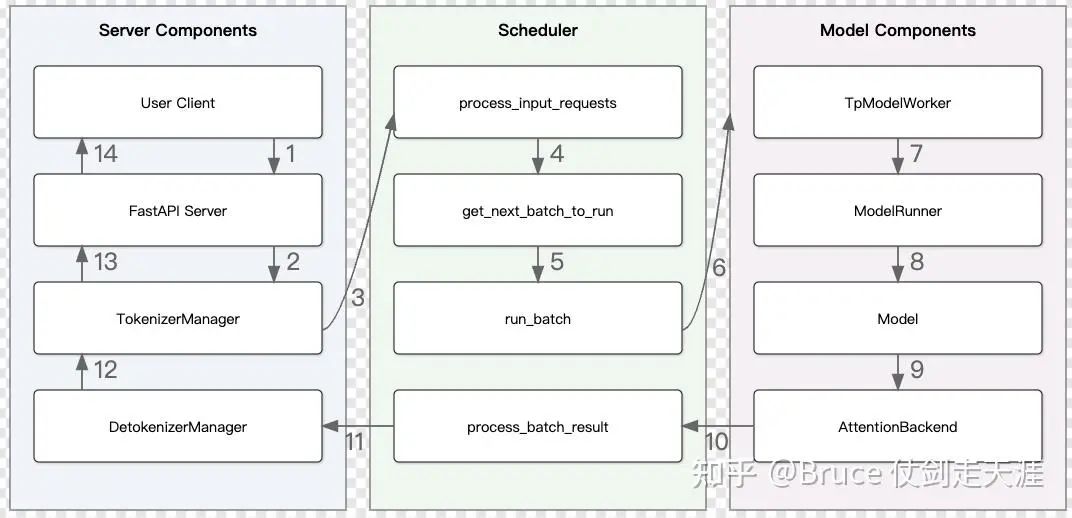
而本文则主要关注于kvcache 管理这一层,但由于kvcache 是全局资源,与其交互过程是遍布全流程的,所以也必须理解请求,batch,scheduler的行为。如果懒得看,可以直接看文章末尾At Last的总结。
sglang的kv cache 管理相关模块
首先为了方便翻阅,我们列出相关目录。
最直接的cache 类实现在 python/sglang/srt/mem_cache[3],包含两大类结构,基于BasePrefixCache的类(chunked cache,radix cache)以及memory_pool。前者大家都有直接的印象,就是kvcache,后者则是管理映射关系,主要有两类映射:reqtotoken,tokentokv。前者是请求和生成token的映射关系,后者是token和kvcache的映射关系,由于kvcache真实操作的差异,也包括MHA,MLA,double sparsity的实现。
为了方便大家理解,我们也必须了解核心的调度层数据结构,上层结构基本都在manager层,代码目录 python/sglang/srt/managers[4],这是一个完整的LLM serving框架,包括tokenizer/detokenizer,session 管理,scheduler等,kvcache的核心涉及角色是scheduler以及tp_worker。sglang中对于执行逻辑的抽象关系,有过说明:
The following is the flow of data structures for a batch:
ScheduleBatch -> ModelWorkerBatch -> ForwardBatch
- ScheduleBatch is managed by `scheduler.py::Scheduler`.
It contains high-level scheduling data. Most of the data is on the CPU.
- ModelWorkerBatch is managed by `tp_worker.py::TpModelWorker`.
It is a subset of `ScheduleBatch` that only contains data related to the model forward on GPU.
It will be transformed from CPU scheduler to GPU model runner.
- ForwardBatch is managed by `model_runner.py::ModelRunner`.
It contains low-level tensor data. Most of the data consists of GPU tensors.上述中,forward batch即在model_executor,是底层抽象,往上是ModelWorkerBatch(位于tp_worker),再往上是ScheduleBatch(位于scheduler)。理解了batch的流动以及req,kvcache,batch的关系,就基本可以理解kvcache在这三层之间的关系。
接下来,是推理核心实现之一,model_executor。目录位于python/sglang/srt/model_executor[5], 具体的forward 前的调度和处理工作集中在model_runner,包括sampling、rope,cuda_graph,kv_cache 的选择和配置等等,通过forward_batch_info.py 我们可以看到sglang除支持常规的prefill、decode、prefill with prefix cache外,也支持了投机推理。
最后,即是真正的后端,位于python/sglang/srt/layers[6]和flahsinfer[7],这里会对kv cache进行实际操作进行attention的计算。是真正的核心实现之一。
原则上完整的推理栈还会经过model,但是sglang中model 对具体的kvcache 操作不感知,故不特别分析了。为了解释方便,我们先以传统的MHA路径进行分析,MLA和doubleSparsity后续再找机会单独分析。
最后,由于内容实在太多,所以有关真正的后端flashinfer以及attentionbackend、cudagraph runner的实现,我们会放到下篇来继续,本篇集中在model_executor和scheduler 这一层。
KV Cache 基础类
首先是最基础的数据结构ReqToTokenPool与BaseTokenToKVPool,为了语意完整,我们直接看ReqToTokenPool和MHATokenToKVPool。
ReqToTokenPool
ReqToTokenPool 核心数据结构就是free_slots以及req_to_token_pool。req_to_token_pool 是一个两维数组,size指请求容量,max_context_len指一个请求的最大token 数量,这就一目了然了。该数据结构对外提供的功能就是通过free_slots对请求所需资源进行分配和释放,通过req_to_token_pool 进行对req-token映射的记录。
self.req_to_token = torch.zeros(
(size, max_context_len), dtype=torch.int32, device=device
)
self.free_slots = list(range(size))此外,对映射内容的修改,通过write接口实现,该接口被schedule 上层调用。
def write_without_records(self, indices, values):
self.req_to_token[indices] = valuesMHATokenToKVPool(BaseTokenToKVPool)
以MHA的class 为例, 这里的核心数据结构如下
free_slots:与ReqToTokenPool 一样,分配空闲slot用的,尺寸不同,是token的数量
free_groups:可以理解为free_slot的小数组,目的是批量释放slot,最终free_group里的slot会回到free_slots
k_buffers,v_buffers:kv buffer。不同的算法,kvcache的管理可能不同,比如MHA和MLA是不同的。但一维都是layer,是统一的
如下的格式,相信大家都比较好理解。
self.k_buffer = [
torch.empty(
(self.size + 1, self.head_num, self.head_dim),
dtype=self.store_dtype,
device=self.device,
)
for _ in range(self.layer_num)
]
self.v_buffer = [
torch.empty(
(self.size + 1, self.head_num, self.head_dim),
dtype=self.store_dtype,
device=self.device,
)
for _ in range(self.layer_num)
]但是我们还需要注意下面的类型转换,存储类型不支持float8_e5m2,会转成uint8.
self.dtype = dtype
if dtype == torch.float8_e5m2:
# NOTE: Store as torch.uint8 because Tensor index_put is not implemented for torch.float8_e5m2
self.store_dtype = torch.uint8
else:
self.store_dtype = dtype在attentionbackend的部分,会有许多对kv cache的set/get操作,而上层几乎只对free_slots进行free/alloc的操作,起到一个资源分配的作用。
现在我们可以看一下Cache类了,为了说明简单,我们只介绍chunkedCache。有关radix Cache 我们会后面单独介绍。
ChunkCache
sglang 支持prefixCache,所以默认的基础类就支持prefix的共用,chunkCache是BasePrefixCache的子类。
关键数据结构如下,首先是Entry的成员,rid是request id的缩写,value是token indice的数组。
class ChunkCacheEntry:
def __init__(self, rid, value):
self.rid = rid
self.value = value
class ChunkCache(BasePrefixCache):
def __init__(
self, req_to_token_pool: ReqToTokenPool, token_to_kv_pool: BaseTokenToKVPool
):
self.disable = True
self.req_to_token_pool = req_to_token_pool
self.token_to_kv_pool = token_to_kv_pool
self.reset()
def reset(self):
self.entries = {}用一张图简单理解cache entries,req_to_token_pool与token_to_kv_pool,kv cache的关系。
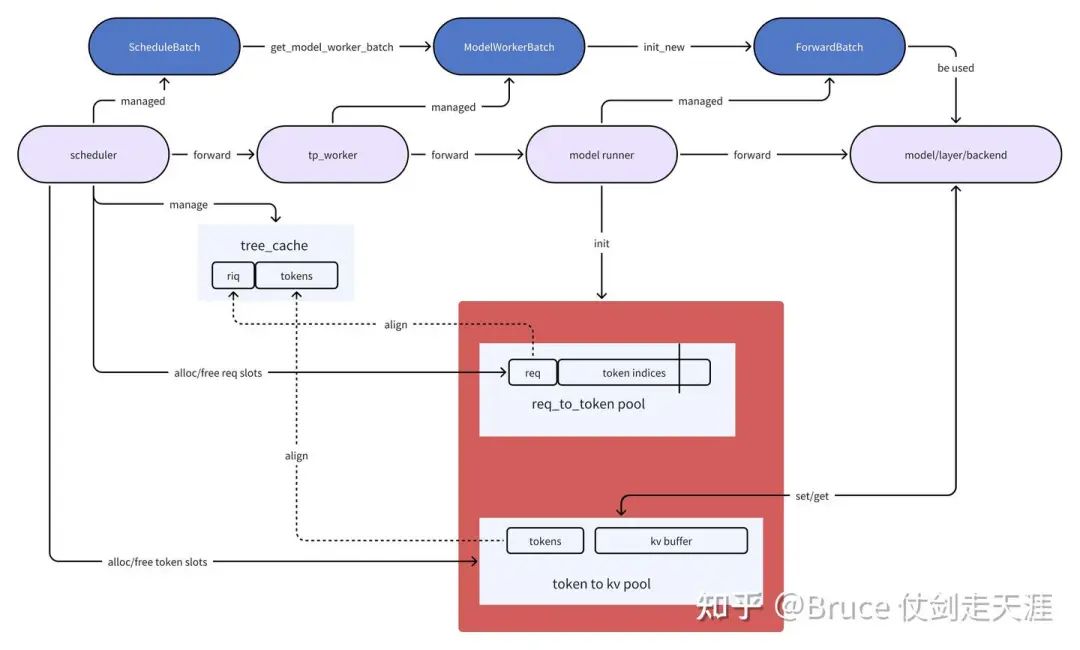
此外,Cache类 还有三个比较重要的接口函数(其他接口函数介绍radix cache再介绍)。
@abstractmethod
def match_prefix(self, **kwargs) -> Tuple[List[int], int]:
pass
@abstractmethod
def cache_finished_req(self, **kwargs):
pass
@abstractmethod
def cache_unfinished_req(self, **kwargs):
passmatch_prefix 就是前缀匹配,cache_unfinished_req即cache数据到cache entry中,cache_finished_req主要是从cache中清除相关信息(为什么取这个名字有点纳闷)。上述三个接口都将在schedule中被使用。
RadixCache
我们之所以看这个数据结构,主要是由于schedulePocily 使用了这个结构,用于安排调度的优先级。知道radixTree的朋友,看见这个名字应该猜的出来。RadixCache 与chunkCache 不同的点在于,chunkCache 管理Cache 是用的字典结构,radixCache 则使用radixtree 来管理。实际上就是管理前缀,这里最大的变化在于前缀匹配的实现(match_prefix)。对于chunkCache来说,prefix match是取entry.value 前max_prefix_len的值;对于radixCache来说,这是一个前缀树匹配的操作。match_prefix 的用处在于利用公共前缀的kvcache,减少prefill的开销,radixCache在前缀匹配的准确性上相比chunkCache 还是靠谱很多的,所以也更有可能达到减少prefill 开销的目的。
数据结构上radixCache如下,可见区别主要就是多了radixtree相关的结构。
self.req_to_token_pool = req_to_token_pool
self.token_to_kv_pool = token_to_kv_pool
self.disable = disable
self.root_node = TreeNode()
self.root_node.key = []
self.root_node.value = []
self.root_node.lock_ref = 1
self.evictable_size_ = 0此外,radixTree作为一种便于高效检索和插入的数据结构,在调度中也会用到。这里特别介绍一个radix 独有实现的接口
def evict(self, num_tokens: int, evict_callback: Callable):
这是一个清资源的接口,这个的意思是,从cache 中清掉num_tokens个数的entry,并且调用evict_callback清空资源
注意,这个函数有两个退出条件:1. 清理出来了num_tokens的显存;2. 已经没有可清理的token
注意,对于正在使用的显存,不会清理(通过ref)判断调度基础类
SchedulePolicy
如下可以看到schedulePolicy里默认使用了RadixCache作为waiting_queue_radix_tree用于任务调度。sglang 支持两种调度策略:CacheAwarePolicy即缓存感知的调度策略,CacheAgnosticPolicy 不感知缓存的策略,这里的缓存指的就是treecache。各自又有几种策略,比如最长匹配,带权重的深度优先搜索,最长输出等等,主要用于给waiting queue排序,waiting queue就是待处理的请求队列。
class CacheAwarePolicy(Enum):
"""Scheduling policies that are aware of the tree cache."""
LPM = "lpm" # longest prefix match
DFS_WEIGHT = "dfs-weight" # depth-first search weighting
class CacheAgnosticPolicy(Enum):
"""Scheduling policies that are not aware of the tree cache."""
FCFS = "fcfs" # first come first serve
LOF = "lof" # longest output first
RANDOM = "random"
class SchedulePolicy:
Policy = Union[CacheAwarePolicy, CacheAgnosticPolicy]
def __init__(self, policy: str, tree_cache: BasePrefixCache):
self.policy = self._validate_and_adjust_policy(policy, tree_cache)
self.tree_cache = tree_cache
# It is used to find the matching prefix for in-batch prefix caching.
self.waiting_queue_radix_tree = RadixCache(
req_to_token_pool=None, token_to_kv_pool=None, disable=False
)schedulePolicy这个类最重要的接口函数是calc_priority,具体细节后面补充吧,可以看到下面的代码,根据配置和waiting queue的请求情况,进行排序,如果是FCFS就不用重排序了。
def calc_priority(self, waiting_queue: List[Req]) -> bool:
policy = self._determine_active_policy(waiting_queue)
prefix_computed = False
if isinstance(policy, CacheAwarePolicy):
prefix_computed = True
temporary_deprioritized = self._compute_prefix_matches(
waiting_queue, policy
)
if policy == CacheAwarePolicy.LPM:
SchedulePolicy._sort_by_longest_prefix(
waiting_queue, temporary_deprioritized
)
elif policy == CacheAwarePolicy.DFS_WEIGHT:
SchedulePolicy._sort_by_dfs_weight(waiting_queue, self.tree_cache)
else:
raise ValueError(f"Unknown CacheAware Policy: {policy=}")
else:
if policy == CacheAgnosticPolicy.FCFS:
pass
elif policy == CacheAgnosticPolicy.LOF:
SchedulePolicy._sort_by_longest_output(waiting_queue)
elif policy == CacheAgnosticPolicy.RANDOM:
SchedulePolicy._sort_randomly(waiting_queue)
else:
raise ValueError(f"Unknown CacheAgnostic Policy: {policy=}")
return prefix_computed当然了这里有一些细节的优化,有兴趣可以仔细阅读这部分代码,我这里提两个:
_determine_active_policy 中如果发现等待队列太长且默认采用的是LPM(最长前缀匹配),则换成FCFS。但如果是dfs-weight则不影响,本质还是计算成本的权衡。
def _determine_active_policy(self, waiting_queue: List[Req]) -> Policy:
if len(waiting_queue) > 128 and self.policy == CacheAwarePolicy.LPM:
# Turn off the expensive prefix matching and sorting when the #queue is large.
return CacheAgnosticPolicy.FCFS
return self.policy_compute_prefix_matches 有一种提高缓存命中率的策略in-batch prefix caching。如果当前batch(waiting queue)中,有不少请求有同一个前缀,而且前缀在已有cache中仅匹配了一小部分(<IN_BATCH_PREFIX_CACHING_CHECK_THRESHOLD),为了提高整体的cache hit rate,仅优先调度前几个请求(<IN_BATCH_PREFIX_CACHING_DEPRIORITIZE_THRESHOLD),其他会被放到waiting queue的尾端。
# NOTE(sang): This logic is for in-batch prefix caching;
# If there are more than 1 request that have small matching prefix from
# existing cache, but all those requests share the same prefix, we prefer
# to schedule only one of them so that we can increase the cache hit rate.
# We prefer to set IN_BATCH_PREFIX_CACHING_CHECK_THRESHOLD > 0 because too small
# threshold means we cannot use in-batch prefix caching for short prefixes.
# It is kind of common when the engine is long running (e.g., imagine the prefix "the").PrefillAdder
第二个和调度相关的类是PrefillAdder,它决定了还能不能插入新请求,其返回有三种,语义很字面直白。
class AddReqResult(Enum):
CONTINUE = auto() # Continue to add requests
NO_TOKEN = auto() # No token left
OTHER = auto() # Other reasons to stop adding requestsPrefillAdder核心数据结构如下,关键是rem_total_tokens,rem_input_tokens,rem_chunk_tokens。他们的区别是:
-
• rem_total_tokens 包括prefill和decoding 一共的上下文长度 -
• rem_input_tokens 则只包括prefill 的输入 -
• rem_chunk_tokens 则是一个chunk可以包含的token数
## in python/sglang/srt/managers/schedule_policy.py
class PrefillAdder:
def __init__(
self,
tree_cache: BasePrefixCache,
running_batch: ScheduleBatch,
new_token_ratio: float,
rem_total_tokens: int,
rem_input_tokens: int,
rem_chunk_tokens: Optional[int],
mixed_with_decode_tokens: int = 0,
):
self.tree_cache = tree_cache
self.running_batch = running_batch
self.new_token_ratio = new_token_ratio
self.rem_total_tokens = rem_total_tokens - mixed_with_decode_tokens
self.rem_input_tokens = rem_input_tokens - mixed_with_decode_tokens
self.rem_chunk_tokens = rem_chunk_tokens
if self.rem_chunk_tokens is not None:
self.rem_chunk_tokens -= mixed_with_decode_tokens
self.cur_rem_tokens = rem_total_tokens - mixed_with_decode_tokens
self.req_states = None
self.can_run_list = []
self.new_being_chunked_req = None
self.log_hit_tokens = 0
self.log_input_tokens = 0我们可以用一个简单的接口函数,来体会返回状态和这几个关键变量的关系,如下函数是add_one_req 请求的最后一个环节,用来最终判断是否可以插入请求。
def budget_state(self):
if self.rem_total_tokens <= 0 or self.cur_rem_tokens <= 0:
return AddReqResult.NO_TOKEN
if self.rem_input_tokens <= 0 or (
self.rem_chunk_tokens is not None and self.rem_chunk_tokens <= 0
):
return AddReqResult.OTHER
return AddReqResult.CONTINUE当然,判断返回的地方不只这个函数,具体可以阅读PrefillAdder add_one_req源码理解。对于理解kvcache 管理,目前这点可能就够了。最后,可以被插入的请求都会放在can_run_list这个列表中。
Req
Req 是核心请求类,包括判断请求是否可以结束,以及核心的数据结构。在介绍req 核心结构前,先简单看看几种finish reason。
FINISH_MATCHED_TOKEN # 匹配了终止的token,比如tokenizer,sampler,scheduler 等设置的eos token
FINISH_MATCHED_STR # 匹配了终止的字符串,一般是sampler设置的
FINISH_LENGTH # 匹配了最大输出长度
FINISH_ABORT # 由于其他原因终止,比如请求不合法等等req 核心成员变量较多,但为了理解调度,我们有必要过一些。为了方便分析,分为几段介绍。首先是输入输出信息,也是最重要的。
# Input and output info
self.rid = rid #请求id, chunkedCache entry的key
self.origin_input_text = origin_input_text #原始请求输入文本字符串
self.origin_input_ids_unpadded = ( #原始请求输入token list
origin_input_ids_unpadded
if origin_input_ids_unpadded
else origin_input_ids # Before image padding
)
self.origin_input_ids = origin_input_ids #也是原始请求输入,但可能是padding过后的。
#通常和origin_input_ids_unpadded一样
#在image input下,sglang对输入做额外的padding,则有区别
self.output_ids = [] # Each decode stage's output ids #输出token list
self.fill_ids = None # fill_ids = origin_input_ids + output_ids # 完整的上下文token list
self.session_id = session_id # 会话id,一轮用户会话可能有多个请求
self.input_embeds = input_embeds # embedding 化后的输入
# Memory pool info
self.req_pool_idx = None #对于req_token_pool的索引其次是用于判断结束的成员变量
# Check finish
self.tokenizer = None # tokenizer,可以用于eos等stop token判断
self.finished_reason = None # 结束理由
self.to_abort = False # 是否是finished_abort
self.stream = stream # 是否是流式的请求
self.eos_token_ids = eos_token_ids # eos token list,用于结束判断然后是用于推理的成员变量
# For incremental decoding
# ----- | --------- read_ids -------|
# ----- | surr_ids |
# xxxxx | xxxxxxxxxxx | xxxxxxxxxxx |
# ----- ^ ----------- ^ ----------- ^
# ----- 1 ----------- 2 ----------- 3
# 1: surr_offset
# 2: read_offset
# 3: last token
self.surr_offset = None # Surrounding offset to defeat the cleanup algorithm
self.read_offset = None
# 上图已经说明了surr_offset和read_offset的区别
# surr_offset通常记录上一次处理到的位置,read_offset 说明正在处理的位置
self.decoded_text = "" # 解码的输出
# Prefix info,与共享prefix 的kvcache 有关
self.prefix_indices = []
# Tokens to run prefill. input_tokens - shared_prefix_tokens.
self.extend_input_len = 0
self.last_node = None
# Chunked prefill
self.is_being_chunked = 0
# The number of cached tokens, that were already cached in the KV cache
# cached的tokens
self.cached_tokens = 0
self.vid = 0 # version id to sync decode status with in detokenizer_manager
# 只有jumpforward 会对其进行修改,同步detokenizer的状态
# For retraction # 用于撤回类似的功能,即需要回退decode 的输出
self.is_retracted = False
# Constrained decoding, 一般用于类似json的结构化输出
self.grammar: Optional[BaseGrammarObject] = None
# Sampling info
self.sampling_params = sampling_params
self.lora_path = lora_path
#剩下一众logits 相关的,为了方便大家理解源码,我这里也介绍
self.return_logprob # 是否有必要返回logits
self.logprob_start_len # 从哪个位置开始算logits
self.extend_logprob_start_len #, extend_即extend的部分开始算,简单理解extend_logprob_start_len = extend_logprob_start_lens - prefix_len
self.normalized_prompt_logprob #归一化后prompt的logits
# _idx 的list,即token 本身(idx 指词表里的index)
# _val 的list,即log值,即分布概率
# _output 和 _input 即输入输出,top即按照val 的top分布
self.top_logprobs_num
self.output_token_logprobs_idx
self.output_token_logprobs_val
self.output_top_logprobs_idx
self.output_top_logprobs_val
self.input_token_logprobs_idx
self.input_token_logprobs_val上面提到jump forward decodig,有些同学可能不熟悉,这里简单介绍一下jump forward,其实这很容易理解,prompt 有时候会是一种类似“完形填空”的方式,而我们只需要生成其中”空白“的部分,不需要生成prompt 已经有的部分。图例如下。
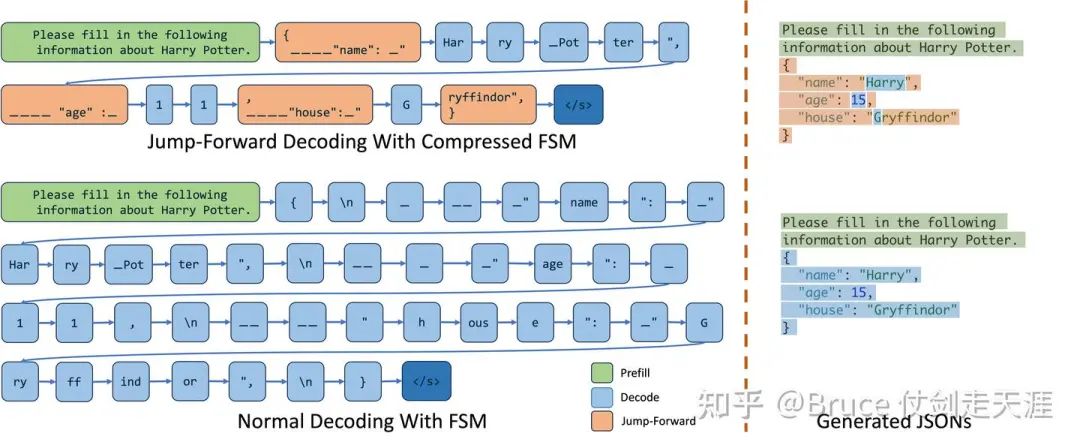
最后我们再介绍一下req 几个比较重要的成员函数。
第一组:
finished() && check_finished() 用于判断是否可以结束,以及finished_reason 是哪种情况
第二组:
init_next_round_input #初始化本请求下一轮inference 需要的参数,比如计算需要用多长的kvcache
(主要是计算fill_ids和extend_input_len)
第三组:
init_incremental_detokenize 与 get_next_inc_detokenization
这两个函数通常是用于获取下一轮detokenizer 相关的参数并进行相关配置
逻辑上,detokenizer 自己会管理相关配置,req的这两个接口主要是for jump forward decoding,
由于jump forward的解码过程存在一些跳跃,所以需要请求级别自己去配置
同理上面也只有jump forward 需要单独提供detokinizer的vid,其他detokenize manager 自己就可以管理
第四组:
jump_forward_and_retokenize
也是jump forward 相关
所以我们看到jump forward和结构化输出相关,在sglang 这边也是一个相当重要的角色。
第五组:
reset_for_retract
为了撤回decode,重置decode 参数,比如ModelConfig & ForwardMode
为了更方便理解SchdeuleBatch,我们还需要了解两个类,一个是modelConfig,另一个是forwardmode。
forward mode 主要是说明了sglang 支持的各种inference 模式,包括如下8种。
class ForwardMode(IntEnum):
# Prefill a new sequence. This is deprecated now. "EXTEND" covers this case.
PREFILL = auto()
# Extend a sequence. The KV cache of the beginning part of the sequence is already computed (e.g., system prompt).
# 即带cache的prefill,场景上覆盖了PREFILL
EXTEND = auto()
# Decode one token.
DECODE = auto()
# Contains both EXTEND and DECODE when doing chunked prefill.
# 即一个batch 里既有prefill,又有decode
MIXED = auto()
# No sequence to forward. For data parallel attention, some workers wil be IDLE if no sequence are allocated.
IDLE = auto() # 空闲
# Used in speculative decoding: verify a batch in the target model.
TARGET_VERIFY = auto()
# Used in speculative decoding: extend a batch in the draft model.
DRAFT_EXTEND = auto()
# 上面两个是投机推理的模式,自回归不会用到。了解投机推理的应该很好理解这两个阶段。
# A dummy first batch to start the pipeline for overlap scheduler.
# It is now used for triggering the sampling_info_done event for the first prefill batch.
# 这是一个特殊的模式,用于初始化scheduler的各种配置和相关预热 ,是第一个batch的forward 模式
DUMMY_FIRST = auto()ModelConfig则是有关inference的配置。其中重要的参数如下:
self.model_path = model_path #模型路径
self.revision = revision # 版本,主要是拿开源配置用
self.quantization = quantization #量化
# Parse args, huggingface 开源配置,还允许override 配置
self.model_override_args = json.loads(model_override_args)
self.hf_config = get_config(
model_path,
trust_remote_code=trust_remote_code,
revision=revision,
model_override_args=self.model_override_args,
)
self.hf_text_config = get_hf_text_config(self.hf_config)
self.dtype = _get_and_verify_dtype(self.hf_text_config, dtype)
# Check model type
self.is_generation = is_generation_model( # 是不是生成模型
self.hf_config.architectures, is_embedding
)
self.is_multimodal = is_multimodal_model(self.hf_config.architectures) # 是不是多模态
self.is_encoder_decoder = is_encoder_decoder_model(self.hf_config.architectures) #是不是encoder-decoder模式
# 模型的配置信息,比如是MHA还是MLA,支持最大上下文长度,各自dim,lora/rope
# 逻辑上有了下面这堆参数,我们可以计算出kvcache需要多少
self.context_len = context_length
self.head_dim = 256
self.attention_arch = AttentionArch.MLA
self.kv_lora_rank = self.hf_config.kv_lora_rank
self.qk_rope_head_dim = self.hf_config.qk_rope_head_dim
self.num_attention_heads = self.hf_text_config.num_attention_heads
self.num_key_value_heads = self.num_attention_heads
self.hidden_size = self.hf_text_config.hidden_size
self.num_hidden_layers = self.hf_text_config.num_hidden_layers
self.vocab_size = self.hf_text_config.vocab_size #词表大小,和tokenizer/sampling有关
self.hf_eos_token_id = self.get_hf_eos_token_id() # 终止tokenlistScheduleBatch->ModelWorkerBatch->ForwardBatch
接下来,我们隆重介绍batch三兄弟里的第一位,schedule batch,他是最上层的batch 结构,和scheduler 直接交互。有了以上的铺垫,理解scheduleBatch就相对简单了。
reqs: List[Req] # batch 内包含的req list
decoding_reqs: List[Req] = None # 仅包含需要decoding的req list(区别于prefill,extend)
req_to_token_pool: ReqToTokenPool = None # 使用的req_to_token_pool和token_to_kv_pool,tree_cache
token_to_kv_pool: BaseTokenToKVPool = None
tree_cache: BasePrefixCache = None推理配置,用于说明当前batch的类型,模型参数,sampling参数。
# Batch configs
model_config: ModelConfig = None
forward_mode: ForwardMode = None
enable_overlap: bool = False #允许overlap,减少overhead,提高性能
# Device
device: str = "cuda"
# 能否使用cuda graph跑dp
can_run_dp_cuda_graph:boolbatch 信息,即一个batch 包含哪些请求级信息
# Sampling info,提供next_batch的采样信息是为了更多信息进行性能优化
sampling_info: SamplingBatchInfo = None
next_batch_sampling_info: SamplingBatchInfo = None
#req 里各项的list, like: batch.input_ids = [req0.input_ids, req1.input_ids... ]
input_ids: torch.Tensor = None
input_embeds: torch.Tensor = None
req_pool_indices: torch.Tensor = None
seq_lens: torch.Tensor = None
# req_pool_indice是req_to_token_pool里的索引,out_cache_loc 是token_to_kv_pool里的索引
# The output locations of the KV cache
out_cache_loc: torch.Tensor = None
output_ids: torch.Tensor = None #输出list
# The sum of all sequence lengths
seq_lens_sum: int = None
# For DP attention
global_num_tokens: Optional[List[int]] = None
# For extend and mixed chunekd prefill
prefix_lens: List[int] = None
extend_lens: List[int] = None
extend_num_tokens: int = None这里辨析一下,seq_lens,seq_lens_sum,global_num_tokens,extend_num_tokens 的区别:
-
• seq_lens 是一个list(或者tensor),每个请求的seq_len是内部一项 -
• seq_lens_sum 是seq_lens的总和,即sum(seq_lens), 对于prefill是个重要的负载参考 -
• global_num_tokens 是系统内所有的token和,简单理解就是假如我们有4个dp worker,每个dp worker有一个seq_lens_sum,global_num_tokens即4个dp worker的seq_lens_sum之和 -
• extend_num_tokens 即一个batch内用于extend计算的token数量
其他成员变量还包括特殊请求的模式相关,如下。
# For encoder-decoder encoder-decoder架构
encoder_cached: Optional[List[bool]] = None
encoder_lens: Optional[torch.Tensor] = None
encoder_lens_cpu: Optional[List[int]] = None
encoder_out_cache_loc: Optional[torch.Tensor] = None
# Stream #流式请求
has_stream: bool = False
# Has grammar #结构化请求
has_grammar: bool = False
# Speculative decoding #投机推理
spec_algorithm: SpeculativeAlgorithm = None
spec_info: Optional[SpecInfo] = None
接下来可以介绍scheduleBatch的几个核心成员函数了。首先是资源分配释放相关。
alloc_req_slots,为reqs里每个req分配req_to_token_pool 里的一个独立的索引/slot
alloc_token_slots,为每个token 分配token_to_kv_pool 里的一个独立的索引
check_decode_mem,看看有没有out of mem(看看token_to_kv_pool 有没有空slot)
# 我们稍微详细展开说明一下check_decode_mem 函数,buf_multiplier在投机推理下会变,我们默认为1即可
def check_decode_mem(self, buf_multiplier=1):
bs = len(self.reqs) * buf_multiplier
# 如果当前剩余显存,够当前bs 推理,则返回true
if self.token_to_kv_pool.available_size() >= bs:
return True
# 从当前的tree_cache 中,尝试清理足够的显存出来,具体清理逻辑看上述evict的说明
self.tree_cache.evict(bs, self.token_to_kv_pool.free)
# 如果清理后,有足够显存,则返回true,其他返回flase
if self.token_to_kv_pool.available_size() >= bs:
return True
return False然后是为各种forward模式准备batch info,如下,理解了batchinfo的字段含义,理解这些代码是比较简单的。主要注意的是,这里会真实操作kvcache,比如prepare_for_decode会调用alloc_token_slots为token 分配显存空间,而prepare_for_extend 还会多调用alloc_req_slots 分配请求空间(就是一条record)。
prepare_for_idle
prepare_for_extend
prepare_for_decode
prepare_encoder_info_extend
prepare_encoder_info_decode
mix_with_runningbatch操作相关
def filter_batch(
self,
being_chunked_req: Optional[Req] = None,
keep_indices: Optional[List[int]] = None,
)
#该函数用于获得过滤后的batch,过滤条件是req的req_pool_indice在keep_indices内。
#或者keep_indices为None下,过滤条件是reqs中不为being_chunked_req的请求而且请求没有结束
def merge_batch(self, other: "ScheduleBatch"):
#将others里的batch 合并到本batch中,这里有一个值得注意的是,为了保障安全
#我们需要将sampling 先进行合并,因为sampling内惩罚的合并是依赖合并前的batch 请求的
get_model_worker_batch
# 用于将一个schedulebatch 转变成tp worker可以处理的ModelWorkerBatch,参数和schedulebatch几乎没有差别
# 但ModelWorkerBatch有一个用triton的write_req_to_token_pool_triton,成员函数
# 大家可以看看triton api怎么操作python指针,比如req_to_token_pool的指针并进行数据修改特殊情况,比如jump forward和撤回,按照前面的解释理解即可。
retract_decode,check_for_jump_forwardforwardbatch 是 batch 三兄弟的最后一个,逻辑上这一部分和Flashinfer等attentionBackend 关系更密切。本应该放到下篇讲,但是这个结构也是承上启下的中枢,forwardbatch 之上可以认为是runtime的代码,forward 以下是真正推理层的代码。
Class ForwardBatch:
# The forward mode
forward_mode: ForwardMode
# The batch size
batch_size: int
# The input ids
input_ids: torch.Tensor
# The indices of requests in the req_to_token_pool
req_pool_indices: torch.Tensor
# The sequence length
seq_lens: torch.Tensor
# The indices of output tokens in the token_to_kv_pool
out_cache_loc: torch.Tensor
# The sum of all sequence lengths
seq_lens_sum: int
.....
# Position information
positions: torch.Tensor = None
# For Qwen2-VL
mrope_positions: torch.Tensor = None
gathered_buffer: Optional[torch.Tensor] = None前面部分的数据结构和scheduleBatch 相似,都是batch 相关信息,我们讲一下后面的三个参数。
positions和mrope_positions位置编码参数,是forwardBatch 构造过程才被赋予的,后者是qwen vl 才需要。
而gathered_buffer 是为了gather 所有tp上的数据申请的buffer,dp 才会使用,我们也先按下不表。
forwardBatch主要接口是init_new ,用于基于WorkerModelPatch 获得一个forwardBatch。
不过虽然有这么多mode,实际上推理时都会规约成3类,如下,包括extend/prefill/mixed以及投机推理的情况,都会被认为是extend类型,最后通过backend的extend 接口进行forward,decode和idle 各自作为一种类型。
def is_extend(self):
return (
self == ForwardMode.EXTEND
or self == ForwardMode.MIXED
or self == ForwardMode.DRAFT_EXTEND
or self == self.TARGET_VERIFY
)
def is_decode(self):
return self == ForwardMode.DECODE
def is_idle(self):
return self == ForwardMode.IDLEscheduler的初始化与核心流程
了解了核心数据结构,让我们从顶层schedule 角度看一下cache是如何被使用的。
scheduler 实在是一个功能庞大的集合,这里可以看到许多sglang的内部设计细节,比如用zmq 与tokenizer 进程通信,batch的管理等等,但为了篇幅,我们只集中关注和cache 相关的部分,以及可能涉及到的batch和请求 管理相关逻辑上。先看一下这个sglang 大的执行框架。(有时间补图)
Launch SRT (SGLang Runtime) Server
The SRT server consists of an HTTP server and the SRT engine.
1. HTTP server: A FastAPI server that routes requests to the engine.
2. SRT engine:
1. TokenizerManager: Tokenizes the requests and sends them to the scheduler.
2. Scheduler (subprocess): Receives requests from the Tokenizer Manager, schedules batches, forwards them, and sends the output tokens to the Detokenizer Manager.
3. DetokenizerManager (subprocess): Detokenizes the output tokens and sends the result back to the Tokenizer Manager.
Note:
1. The HTTP server and TokenizerManager both run in the main process.
2. Inter-process communication is done through ICP (each process uses a different port) via the ZMQ library.以上注释位于python/sglang/srt/server.py,在这里整体流程控制在tokenizerManager,httpserver是很薄的,所以这里TokenizerManager是主进程,请求从tokenizerManager进sglang engine,推理结果也最终返回给TokenizerManager,再返回给http server。scheduler和DetokenizerManager 都是子进程,通过mp 拉起来的, 他们之间通过zmq 跨进程通信。现在我们主要关注scheduler,是核心推理进程。scheduler 被server 拉起的主函数如下。
-
• 环境亲和性(cpu,gpu affinity) -
• 在scheduler进程上初始化scheduler类 -
• 进任务循环
if get_bool_env_var("SGLANG_SET_CPU_AFFINITY"):
set_gpu_proc_affinity(server_args.tp_size, server_args.nnodes, gpu_id)
parent_process = psutil.Process().parent()
# Create a scheduler and run the event loop
try:
scheduler = Scheduler(server_args, port_args, gpu_id, tp_rank, dp_rank)
pipe_writer.send(
{"status": "ready", "max_total_num_tokens": scheduler.max_total_num_tokens}
)
if scheduler.enable_overlap:
scheduler.event_loop_overlap()
else:
scheduler.event_loop_normal()
except Exception:
traceback = get_exception_traceback()
logger.error(f"Scheduler hit an exception: {traceback}")
parent_process.send_signal(signal.SIGQUIT)从中可以看到scheduler 我们只关注两个函数,初始化__init__和event_loop_xxx。
scheduler 的初始化
一开始其实就是几步:
-
• 和tokenizerManager,detokenizer manager 建立zmq 连接 -
• 初始化modelconfig等相关系统配置 -
• 初始化tp_worker,tp worker 之间用nccl 通信(这里tp worker 包含tp和dp 两层rank,所以应该是2维去理解) -
• kv cache 和 调度队列相关初始化 -
• 一些特殊配置的初始化,比如多模态,encoder-decoder,投机推理,这些不是本次研究的核心,忽略
我们稍微注意一下tp worker的初始化,因为memory_pool 是从tp_worker里拿的。这里会一路调用到model_runner的初始化。首先说明一下包含关系。继续回忆上面的框架图。
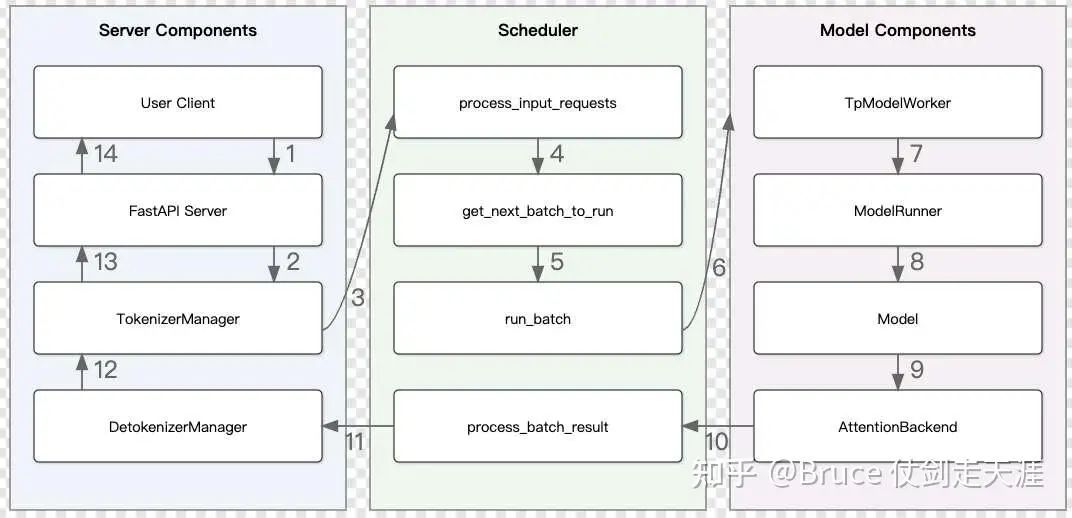
推理的底层核心逻辑在右侧的紫色部分,TpWorker,ModelRunner 以及AttentionBackend 是后面一篇文章的核心,这里仅仅浅浅介绍一下。
首先是TpWorker,TpWorker 是一个完整的worker 线程,不仅仅和tp相关,也和dp相关。所以tpworker的数量是tp_num * dp_num。如下是初始参数,这些参数也会被传给TpWorker里的model_runner。
class TpModelWorker:
"""A tensor parallel model worker."""
def __init__(
self,
server_args: ServerArgs,
gpu_id: int,
tp_rank: int,
dp_rank: Optional[int],
nccl_port: int,
is_draft_worker: bool = False,
):至于TpWorker与TpWorkerClient的关系,其实就是同步和异步的差别,sglang中二者互斥,不可同时共存。TpWorker 自己没有独立的工作线程,都是接口函数,被scheduler 调用;TpWorkerClient则内部有一个自己的工作线程forward_thread_func_,scheduler 通过TpWorkerClient的接口,将任务提交到forward_thread_func_上,由该线程自己调度,以实现更好的overlap,如果enable_overlap 为True,则会选择TpWorkerClient模式。有关TpWorkerClient的工作原理,这里推荐一片文章
深入探讨SGLang异步调度机制:如何实现CPU与GPU流水线的重叠
提到enable_overlap,也介绍当前几个限制。
-
• 非生成模型,比如embedding,禁止enable_overlap -
• 多模态模型,当前禁止enable_overlap -
• 如果enable_overlap,关闭jump forward(不理解为什么disable)。
TpWorker 相对比较薄,重点是ModelRunner,这个东西比较重,我们仅仅介绍其中5个成员函数,与推理过程中的kvcache 操作有比较重要的关系。此外modelRunner 还有一个重要功能,调用model_loader 加载模型。
min_per_gpu_memory = self.init_torch_distributed()
# 这里的关键有几点:
# 1. 初始化分布式beckend,如果是cuda,则会用nccl的后端,
#。 这里的关键函数是init_distributed_environment,从vllm import过来的,这部分分布式以后单独出个章节写
# 2. 获得当前系统中可用的显存(对齐到多个rank上的最小值)
# 这里的关键函数是get_available_gpu_memory,先拿local的free memory,再通过torch.distributed.ReduceOp.MIN
# 获得多个rank中的最小值,作为整个分布式系统的采用值,有趣的是,sglang 还拿最终值和本地值做了一次比较
# 如果min_per_gpu_memory < local_gpu_memory * 0.9, 则会系统层面抛错
self.init_memory_pool(
min_per_gpu_memory,
server_args.max_running_requests,
server_args.max_total_tokens,
)
# 有了min_per_gpu_memory,就可以初始化memory pool了
# max_running_requests是最多可用跑多少请求,max_total_tokens是可以存多少token
# 注意,这里最终传递给token_to_kv_pool的tokens_num 是min(max_total_tokens, profile_num_tokens(min_per_gpu_memory)
# 所以其实是取用户配置和系统状态中的小值
# 分别是req_to_token_pool 和 token_to_kv_pool的数组的一维维度
# 这里也有几个关键步骤:
# 1. 确实kv cache 存储的数据类型,这个配置参数会传进来
# 2. 初始化req_to_token_pool, 维度为(max_num_reqs + 1,self.model_config.context_len + 4)
# 不过这里+1,+4 都是为啥,没看明白
# 3. 根据model config 里的attention,架构,选择对应的token_to_kv_pool,比如MLA,MHA,doubleSparsity等
# 维度是(self.max_total_num_tokens, (head_num, head_dim, layer_num))
if self.device == "cuda":
self.init_cublas()
self.init_attention_backend()
self.init_cuda_graphs()
# 这部分,则是对attentionBackend的初始化,主要包括:
# cublas的初始化(用一个小matmul 做系统预热),初始化attentionbackend和cudagraph接下来我们关注的重点是kvcache和调度相关的初始化。与kv cache 相关的部分主要是如下。
# Init memory pool and cache
self.req_to_token_pool, self.token_to_kv_pool = self.tp_worker.get_memory_pool()
if (
server_args.chunked_prefill_size is not None
and server_args.disable_radix_cache
):
self.tree_cache = ChunkCache(
req_to_token_pool=self.req_to_token_pool,
token_to_kv_pool=self.token_to_kv_pool,
)
else:
self.tree_cache = RadixCache(
req_to_token_pool=self.req_to_token_pool,
token_to_kv_pool=self.token_to_kv_pool,
disable=server_args.disable_radix_cache,
)
self.tree_cache_metrics = {"total": 0, "hit": 0}
self.policy = SchedulePolicy(self.schedule_policy, self.tree_cache)可以看见SchedulePolicy 的初始化也传入了tree_cache,可见kvcache 管理也是直接影响调度的。由下也可见,默认使用radixCache。有了上述的铺垫,这里的内容也就很明了了。
然后是一些调度成员变量,下面会用到,这里也放一下,注释已经很清楚了。
# Init running status
self.waiting_queue: List[Req] = []
# The running decoding batch for continuous batching
self.running_batch: Optional[ScheduleBatch] = None
# The current forward batch
self.cur_batch: Optional[ScheduleBatch] = None
# The current forward batch
self.last_batch: Optional[ScheduleBatch] = None
self.forward_ct = 0 # 第几轮forward
self.forward_ct_decode = 0
self.num_generated_tokens = 0
self.last_decode_stats_tic = time.time()
self.stream_interval = server_args.stream_interval
self.current_stream = torch.get_device_module(self.device).current_stream()接下来是调度过程中会改变调度逻辑的成员
self.init_new_token_ratio = min(
global_config.default_init_new_token_ratio
* server_args.schedule_conservativeness,
1.0,
)
self.min_new_token_ratio = min(
self.init_new_token_ratio
* global_config.default_min_new_token_ratio_factor,
1.0,
)
self.new_token_ratio_decay = (
self.init_new_token_ratio - self.min_new_token_ratio
) / global_config.default_new_token_ratio_decay_steps
self.new_token_ratio = self.init_new_token_ratio
# Tells whether the current running batch is full so that we can skip
# the check of whether to prefill new requests.
# This is an optimization to reduce the overhead of the prefill check.
self.batch_is_full = False上面代码包括两部分,第一部分是new_token_ratio的参数,这个用来控制解码过程中加入新token的比例,用于提高回复的新颖性。第二部分是batch_is_full ,如果当前batch 已经满了,就跳过插入请求的判断。
接着就是watchdog和metric的初始化。
watchdog 就是判断前后两次forward的时间间隔,大于watchdog timeout就认为僵尸/卡住。
metric 用来上报系统指标。
attentionBackend和cudaGraphrunner的初始化与flashinfer和具体推理逻辑有关,下篇介绍。
event_loop_normal
终于我们来到了本章的最后章节。scheduler 主循环。为了说明方便,选择event_loop_normal。
@torch.no_grad()
def event_loop_normal(self):
"""A normal scheduler loop."""
while True:
recv_reqs = self.recv_requests()
self.process_input_requests(recv_reqs)
batch = self.get_next_batch_to_run()
# 先不关注dp 这部分
if self.server_args.enable_dp_attention: # TODO: simplify this
batch = self.prepare_dp_attn_batch(batch)
self.cur_batch = batch
if batch:
result = self.run_batch(batch)
self.process_batch_result(batch, result)
else:
# When the server is idle, so self-check and re-init some states
self.check_memory()
self.new_token_ratio = self.init_new_token_ratio
self.last_batch = batch这里我们主要关注get_next_batch_to_run,run_batch的部分。简单过一下其他几个函数:
-
• recv_requests: 从tokenizermanager 获得新请求(可能是新http请求,也可能是还没推理完需要继续推理的请求,也可能是其他类型的请求,比如flushcache,profile,closesession等等) -
• process_input_requests:处理进来的请求,主要是处理generation的请求,大部份类型的请求不需要进推理,所以走完这个函数也就完了,对于generation(也包括embedding)请求,则会构建Req class,插入到waiting_queue里 -
• 如果没有新batch,进行一些系统检查和参数初始化(new_token_ratio)
get_next_batch_to_run
接下来我们介绍一下核心函数之一get_next_batch_to_run。它的功能是判断下一个batch 做什么。
def get_next_batch_to_run(self) -> Optional[ScheduleBatch]:
# Merge the prefill batch into the running batch
# 这里的意思是合并batch,首先将chunked 请求从当前batch 里拿掉,释放相关资源
# 然后将last_batch 的请求合并到当前running的请求中
if self.last_batch and self.last_batch.forward_mode.is_extend():
if self.being_chunked_req:
# Move the chunked request out of the batch
self.last_batch.filter_batch(being_chunked_req=self.being_chunked_req)
self.tree_cache.cache_unfinished_req(self.being_chunked_req)
# being chunked request keeps its rid but will get a new req_pool_idx
self.req_to_token_pool.free(self.being_chunked_req.req_pool_idx)
self.batch_is_full = False
if not self.last_batch.is_empty():
if self.running_batch is None:
self.running_batch = self.last_batch
else:
self.running_batch.merge_batch(self.last_batch)
# Run prefill first if possible
# 如果有prefill的batch 请求,则优先处理prefill,chunked request 在这里会重新获得相关资源
new_batch = self.get_new_batch_prefill()
if new_batch is not None:
return new_batch
# Run decode
if self.running_batch is None:
return None
# 剩下是decode 的请求,需要进行一些更新
self.running_batch = self.update_running_batch(self.running_batch)
return self.running_batch这里再讲一下get_new_batch_prefill,其实这里有更多的插入判断逻辑。
def get_new_batch_prefill(self) -> Optional[ScheduleBatch]:
# Check if the grammar is ready in the grammar queue
if self.grammar_queue:
self.move_ready_grammar_requests()
# Handle the cases where prefill is not allowed
# 如果batch 已经满了,或者没有新的waiting 请求,也没有chunked prefill请求
# 特别提出来chunked请求,应该是和前面单独从running batch里摘出去了有关,这边要找补回来
if (
self.batch_is_full or len(self.waiting_queue) == 0
) and self.being_chunked_req is None:
return None
# 如果当running batch的size,达到了max_running_requests,说明满了,无法插入
running_bs = len(self.running_batch.reqs) if self.running_batch else 0
if running_bs >= self.max_running_requests:
self.batch_is_full = True
return None
# Get priority queue,具体逻辑请回头看schedule_policy的部分
prefix_computed = self.policy.calc_priority(self.waiting_queue)
# Prefill policy,构建一个PrefillAdder类进行插入处理,具体逻辑和接口函数上面有写
adder = PrefillAdder(
self.tree_cache,
self.running_batch,
self.new_token_ratio,
self.token_to_kv_pool.available_size() + self.tree_cache.evictable_size(),
self.max_prefill_tokens,
self.chunked_prefill_size,
running_bs if self.is_mixed_chunk else 0,
)
has_being_chunked = self.being_chunked_req is not None
if has_being_chunked:
self.being_chunked_req.init_next_round_input()
self.being_chunked_req = adder.add_being_chunked_req(self.being_chunked_req)
# Get requests from the waiting queue to a new prefill batch
# 从新请求的waiting 队列里拿出来,构建请求,如果发现已满,则跳出循环
for req in self.waiting_queue:
if (
self.lora_paths
and len(
lora_set
| set([req.lora_path for req in adder.can_run_list])
| set([req.lora_path])
)
> self.max_loras_per_batch
):
self.batch_is_full = True
break
if running_bs + len(adder.can_run_list) >= self.max_running_requests:
self.batch_is_full = True
break
req.init_next_round_input(None if prefix_computed else self.tree_cache)
res = adder.add_one_req(req)
if res != AddReqResult.CONTINUE:
if res == AddReqResult.NO_TOKEN:
self.batch_is_full = True
break
if self.server_args.prefill_only_one_req:
break
# Update waiting queue
# 如果can_run_list 里为空,也就是因为某些原因,add_one_req 没有返回AddReqResult.CONTINUE的情况
# 返回None,说明没有新prefill 请求
# 那前面说的chunked 请求呢?已经调用过add_being_chunked_req,如果成功也会在can_run_list里
can_run_list = adder.can_run_list
if len(can_run_list) == 0:
return None
## waiting queue重组,不在can run list 里扔进去
self.waiting_queue = [
x for x in self.waiting_queue if x not in set(can_run_list)
]
# 构建一个ScheduleBatch,所以prefill 会拥有一个新batch
# 合理,因为prefill是新请求触发的,请求触发batch 合理
new_batch = ScheduleBatch.init_new(
can_run_list,
self.req_to_token_pool,
self.token_to_kv_pool,
self.tree_cache,
self.model_config,
self.enable_overlap,
self.spec_algorithm,
)
然后为各种forward mode的schedulebatch prepare一下即可最后是update_running_batch,这里会对decode 类型的batch 进行进一步处理。
def update_running_batch(self, batch: ScheduleBatch) -> Optional[ScheduleBatch]:
initial_bs = batch.batch_size()
# 这里的filter 逻辑上其实是再过滤一遍,去掉已经结束的请求,以及prefill的请求
batch.filter_batch()
if batch.is_empty():
self.batch_is_full = False
return None
# 判断是不是超过了decode mem
if not batch.check_decode_mem(self.decode_mem_cache_buf_multiplier) or (
test_retract and batch.batch_size() > 10
):
#如果oom,撤回当前的decode batch,塞到waiting 队列中
# 重新设置new_token_ratio
retracted_reqs, new_token_ratio = batch.retract_decode()
self.new_token_ratio = new_token_ratio
self.waiting_queue.extend(retracted_reqs)
else:
# 每次decode 都会减小新token生成概率
self.new_token_ratio = max(
self.new_token_ratio - self.new_token_ratio_decay,
self.min_new_token_ratio,
)
# Check for jump-forward,判断需不需要jump forward,jump forward 请求也会被filter 出来
# 不当作decode 请求进行推理,放进waiting_queue,作为新请求处理(走extend/prefill mode)
if not self.disable_jump_forward:
jump_forward_reqs = batch.check_for_jump_forward(self.pad_input_ids_func)
self.waiting_queue.extend(jump_forward_reqs)
if batch.is_empty():
self.batch_is_full = False
return None
# 再次判断有没有满batch
if batch.batch_size() < initial_bs:
self.batch_is_full = False
# Update batch tensors
# 为请求分配具体的kv cache,即分配token_to_kv_pool 里的值
batch.prepare_for_decode()
return batch从上述可以看到,get_next_batch_for_run 是一个调度函数,明确下一个batch 具体跑什么类型的哪些请求。我们也可以看到waiting queue和batch 这两个核心结构的用处,waiting queue 放的是需要prefill的请求,不论是新请求,chunked prefill 请求还是jump forward 请求,都会放进waiting queue,等get_new_batch_prefill 对这种请求进行处理、解析并构造一个新的batch。而decode 阶段,会根据上一轮推理的结果,合并batch,尽量将decode 变成一个大的batch进行处理,如果过程中发现存在需要jump forward的请求,则会释放资源,丢回waiting_queue,等get_new_batch_prefill 再去重新分配。
run_batch
第二个核心函数 run_batch。
def run_batch(self, batch: ScheduleBatch):
"""Run a batch."""
self.forward_ct += 1
if self.is_generation:
if batch.forward_mode.is_decode() or batch.extend_num_tokens != 0:
if self.spec_algorithm.is_none():
model_worker_batch = batch.get_model_worker_batch()
logits_output, next_token_ids = (
self.tp_worker.forward_batch_generation(model_worker_batch)
)
else:
(
logits_output,
next_token_ids,
model_worker_batch,
num_accepted_tokens,
) = self.draft_worker.forward_batch_speculative_generation(batch)
self.num_generated_tokens += num_accepted_tokens
elif batch.forward_mode.is_idle():
model_worker_batch = batch.get_model_worker_batch()
self.tp_worker.forward_batch_idle(model_worker_batch)
return
else:
logits_output = None
if self.skip_tokenizer_init:
next_token_ids = torch.full(
(batch.batch_size(),), self.tokenizer.eos_token_id
)
else:
next_token_ids = torch.full((batch.batch_size(),), 0)
batch.output_ids = next_token_ids
ret = logits_output, next_token_ids, model_worker_batch.bid
else: # embedding or reward model
assert batch.extend_num_tokens != 0
model_worker_batch = batch.get_model_worker_batch()
embeddings = self.tp_worker.forward_batch_embedding(model_worker_batch)
ret = embeddings, model_worker_batch.bid
return ret我们先不看其他的branch 逻辑,我们只关注is_generation的部分,也就是生成模型相关,确切的说,只需要理解is_generation的前两个branch。
第一个branch 进去是主逻辑。接下来我们逐步分析
self.forward_ct += 1首先是forward_ct,这个其实就是计数,watchdog 会观察计数变更的间隔,超过阈值,就会报僵尸或者hung住的告警。
if self.is_generation:
if batch.forward_mode.is_decode() or batch.extend_num_tokens != 0:
if self.spec_algorithm.is_none():观察上面这个判断,其实is_decode 很明确,decode 的batch,extend_num_tokens!=0 其实就包括extend和prefill 请求的情况, 当然也包括mix infer的情况,所以generation下,主要是通过这个分支进推理,spec_algorithm.is_none就是非投机推理,也就是自回归解码的模式。
model_worker_batch = batch.get_model_worker_batch()几乎就是一个赋值过程,转成了workerBatch的结构而已。
self.tp_worker.forward_batch_generation(model_worker_batch)
# 真正forward 函数,包括forward和sample 过程,这里的launch_done目前没有地方调用,忽略即可
def forward_batch_generation(
self,
model_worker_batch: ModelWorkerBatch,
launch_done: Optional[threading.Event] = None,
):
#构建一个forwardBatch,forwardBatch里已经有了完整的需要的batch信息(包括位置编码信息)
forward_batch = ForwardBatch.init_new(model_worker_batch, self.model_runner)
# forward 推理,获得logits
logits_output = self.model_runner.forward(forward_batch)
if launch_done:
launch_done.set()
# 采样,从logits->tokens
next_token_ids = self.model_runner.sample(logits_output, model_worker_batch)
return logits_output, next_token_ids而model_runner.forward 逻辑是如下的, 可以见到如果forwardbatch 支持cudagraph,则会优先以cudagraph 方式执行,否则根据各自的forward mode进行推理。
def forward(self, forward_batch: ForwardBatch) -> LogitsProcessorOutput:
if (
forward_batch.forward_mode.is_cuda_graph()
and self.cuda_graph_runner
and self.cuda_graph_runner.can_run(forward_batch)
):
return self.cuda_graph_runner.replay(forward_batch)
if forward_batch.forward_mode.is_decode():
return self.forward_decode(forward_batch)
elif forward_batch.forward_mode.is_extend():
return self.forward_extend(forward_batch)
elif forward_batch.forward_mode.is_idle():
return self.forward_idle(forward_batch)
else:
raise ValueError(f"Invalid forward mode: {forward_batch.forward_mode}")我们浅浅挑一个子函数,看看实现
def forward_decode(self, forward_batch: ForwardBatch):
self.attn_backend.init_forward_metadata(forward_batch)
return self.model.forward(
forward_batch.input_ids, forward_batch.positions, forward_batch
)这里的两个函数就是我们下篇研究attentionBackend 需要核心涉及的函数,这两个接口函数语义比较明确,为forward 在attentionBackend 准备控制信息,并进行实际的forward。具体逻辑先按下不表。
从这里开始,forward的栈如下,大家可以直接看gpt2 model的实现,比较干净和方便分析。在Model,layer和attentionBackend 会涉及set_kv_buffer的操作。
ModelRunner->Model->layer->attentionBackendAt Last-总结
好,现在回到我们的title,本文旨在理解sglang 中的cache,req和batch。接下来我们根据上面的学习笔记,总结这三者。
cache 是被谁使用的?
cache在sglang中,相关的主要是req_to_token_pool, token_to_kv_pool,tree_cache 三个结构。
其中req_to_token_pool 是 一级pool,存储的是请求和token的映射关系;
token_to_kv_pool 是二级pool,存储的是token 和 kvcache的映射关系;
tree_cache 其实是联系两个pool的组织结构,scheduler 调度过程中会频繁访问,并为请求分配req_to_token_pool和token_to_kv_pool中的slot,tree_cache 在调度策略中是个关键角色,根据prefix match的情况,会决定当前请求何时被prefill。
req_to_token_pool和token_to_kv_pool则是实际的pool,对于backend来说,是get & set的对象,尤其是token_to_kv_pool,会调用set_kv_buffer。而req_to_token_pool 则是被scheduler set,被backend/model get的对象。
回到这张图,这里比较完整说明了batch和cache的关系。
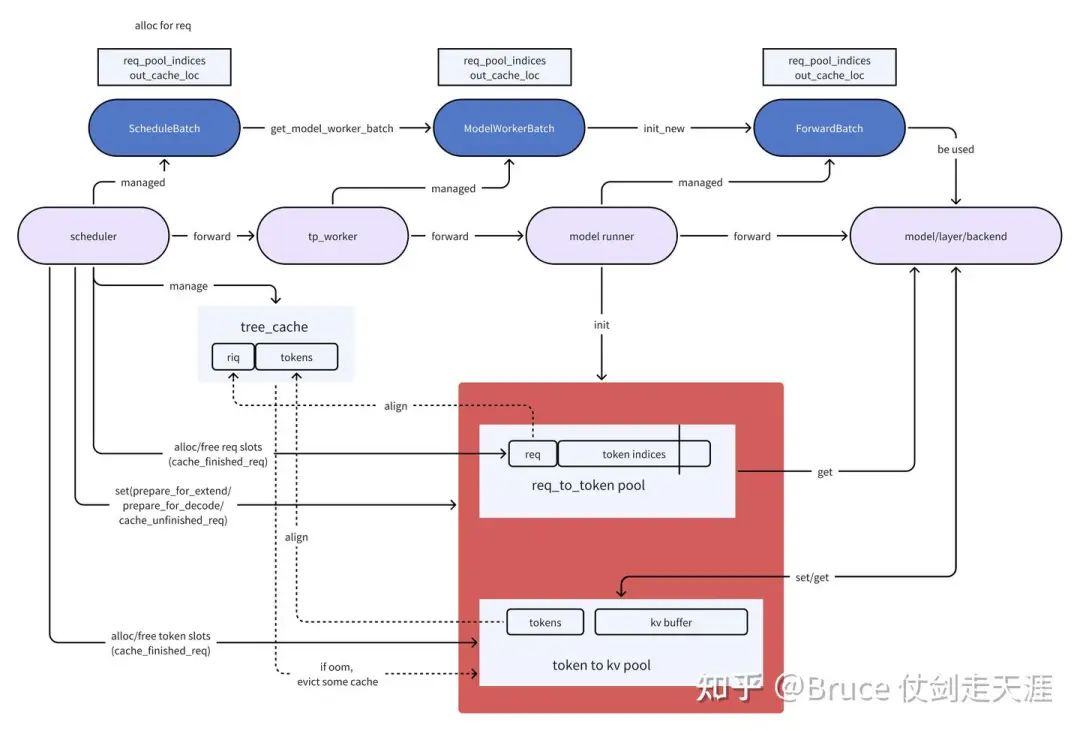
从Req 的lifecycle 观察 cache的lifecycle
另一部分是Req 与 batch的关系,这里我们需要描述scheduler的主体逻辑。
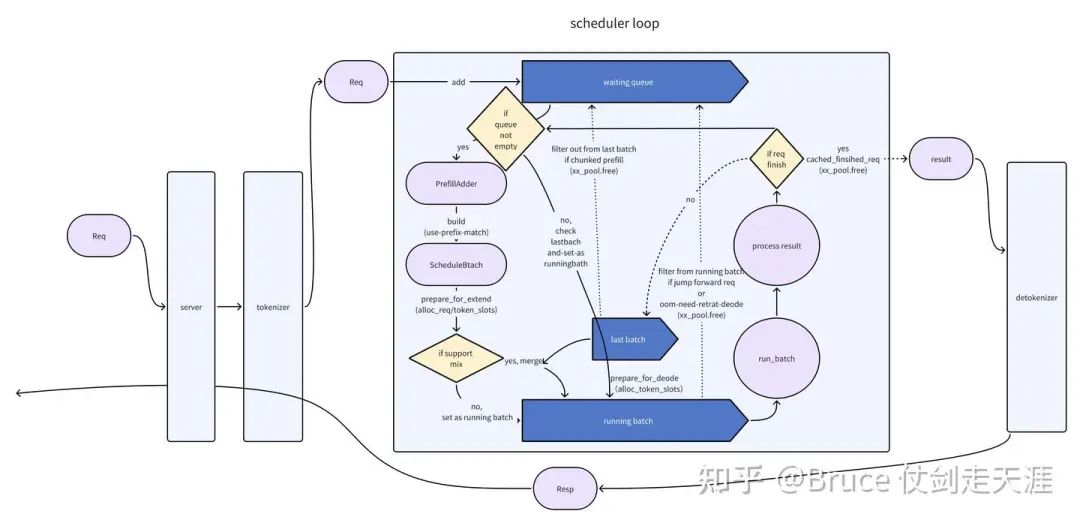
上图我们表述了一个请求的一生,从http server 进来后,传给tokenizer,然后传给schedule 进程。请求先放到waiting queue,随后被scheduler 取出,通过PrefillAdder 构建一个scheduleBatch,作为running batch 进行推理(forward & sample)。如果run_batch完请求结束,发给detokinizer,随后回到tokenizer,从http server 出去。
注意请求的构建和释放,涉及上述cache 资源的分配和释放。
如果run_batch 后请求没有结束,则进行下一轮推理,这里有几个判断。
首先,之前的请求是不是chunked prefill 请求,且prefill 还没有做完,如果是,扔回waiting queue(一切需要prefill的请求,都进waitqueue,作为prefill 请求的总生产者)。
然后,看看waiting queue里有没有新item,有的话,接下来作为mix_running (如果支持mix infer)或者 处理 extend/prefill 请求的batch(上一个请求的decode 被延后)。
如果接下来要做的是decode,判断是否接下来是jump forward请求,如果是,扔回waiting queue(需要prefill),否则进行decode的推理。如果oom,需要撤回当前batch并后续重新build batch,也会扔回waitingqueue。
从上面我们可以看到宏观的cache 在scheduler 里是何时分配,释放的。
scheduler 里如何使用Cache
最后我们补充一下sglang中如何使用cache,也就是set的时机,由于scheduler 主要set req_to_token_pool,所以我们这里也主要介绍req_to_token_pool的逻辑,基于上述源码,理清这里的逻辑线。
scheduler set req_to_token_pool的时机有四个,其中process_batch_result_prefill和get_next_batch_to_run依赖cache_unfinished_req 执行。
|
|
|
|
|
2. 需要单独推理的tokens。从token_to_kv_pool 分配tokens,写进req_to_token pool里 |
|
|
|
|
|
|
|
|
|
为了更好的理解cache的操作,我认为可以仔细看看cache_unfinished_req 这个函数的实现(radix 版本)。
def cache_unfinished_req(self, req: Req, token_ids: Optional[List[int]] = None):
"""Cache request when it is unfinished."""
if self.disable:
return
if token_ids is None:
token_ids = req.fill_ids
# 获得当前完整的输入输出,及其对应的token_to_kv_pool 里的indices
kv_indices = self.req_to_token_pool.req_to_token[
req.req_pool_idx, : len(token_ids)
]
# Radix Cache takes one ref in memory pool
# insert 过程中重新获得prefix cache的长度,并释放token_to_kv_pool 中重复token的部分
new_prefix_len = self.insert(token_ids, kv_indices.clone())
self.token_to_kv_pool.free(kv_indices[len(req.prefix_indices) : new_prefix_len])
# The prefix indices could be updated, reuse it
new_indices, new_last_node = self.match_prefix(token_ids)
assert len(new_indices) == len(token_ids)
# 调用前缀匹配,获得新的prefix indices,将其中未写入的部分写入req_to_token_pool
self.req_to_token_pool.write(
(req.req_pool_idx, slice(len(req.prefix_indices), len(new_indices))),
new_indices[len(req.prefix_indices) :],
)
# 加引用
self.dec_lock_ref(req.last_node)
self.inc_lock_ref(new_last_node)
req.prefix_indices = new_indices
req.last_node = new_last_nodecache_unfinished_req 是一个经典函数,我们可以了解tree_cache,与req_to_token_pool和token_to_kv_pool的相互关系。同时我们可以感觉到sglang 团队对于显存的利用是比较高的,去掉了很多可能的冗余(重复token的kvcache 存储等等)。
这里其实还有一个关键函数是match_prefix,这里其实决定了cache 复用的情况和调度层对cache 复用情况的使用方法。他被用于计算调度的优先级。这一块核心逻辑可以参考schedule policy的说明。
引用链接
[1] flashinfer:https://arxiv.org/pdf/2501.01005[2]code walk through:https://github.com/zhaochenyang20/Awesome-ML-SYS-Tutorial/tree/main/sglang/code-walk-through[3]python/sglang/srt/mem_cache:https://github.com/sgl-project/sglang/tree/b5fb4ef58a6bbe6c105d533b69e8e8bc2bf4fc3c/python/sglang/srt/mem_cache[4]python/sglang/srt/managers:https://github.com/sgl-project/sglang/tree/b5fb4ef58a6bbe6c105d533b69e8e8bc2bf4fc3c/python/sglang/srt/managers[5]python/sglang/srt/model_executor:https://github.com/sgl-project/sglang/tree/b5fb4ef58a6bbe6c105d533b69e8e8bc2bf4fc3c/python/sglang/srt/model_executor[6]python/sglang/srt/layers:https://github.com/sgl-project/sglang/tree/b5fb4ef58a6bbe6c105d533b69e8e8bc2bf4fc3c/python/sglang/srt/layers[7]flahsinfer:https://github.com/flashinfer-ai/flashinfer/tree/9f5fbee3230136b0ccf4a88938d0e244dcaf4b26
往期推荐

深入探讨SGLang异步调度机制:如何实现CPU与GPU流水线的重叠

SGLang代码快速上手(with openRLHF)

SGLang Runtime + Qwen2-7B!解锁开源模型高性能服务
(文:GiantPandaCV)
